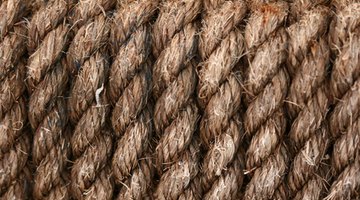How to Preserve Manila Rope
Manila rope is a dull-brown rope made from Abaca plant fibers. It has a hairy appearance, and its texture provides a firm grip and little stretch; the knots tied in manila rope hold well without sliding out. It is often used in gymnastics and in outdoor applications such as climbing and forestry.

Manila rope is resistant to sunlight, which means it won’t melt. It should be cared for properly in order to preserve its strength and quality.
-
Wash manila rope thoroughly if it comes in contact with chemicals. Check the rope ends regularly. Cut worn ends at the first signs of wear.
-
Prevent contact with rough surfaces or sharp edges. All rope can be damaged by abrasion against rough or sharp surfaces. Keep all surfaces that will be in contact with the rope free of burrs and rust. If you are using your rope in a pulley, make sure the pulley turns freely and the rope is the proper size to avoid friction.
-
Avoid putting too much strain on the rope fibers. When a rope is jerked -- or subjected to sudden stresses like rapid stopping or starting of a load -- it puts strain on the rope’s fibers. This can cause the rope to stretch and lose its resiliency. This stress is typically greater on a short rope than on a long rope.
-
Straighten out twists and knots in the rope as soon as possible. Deformation can weaken the rope’s strength by as much as 50 percent.
-
Clean and dry the rope after use. Dirt and grit acts as an abrasive that can damage rope fibers. Store manila rope in a cool dry place that is off the ground. Because it is a natural fiber, manila rope is prone to mildew and dry rot. Keeping it dry will prevent this from happening.
-
Avoid turning twisted manila rope the opposite direction of the rope’s twist or lay. This causes the rope to form a knob, and can cause permanent damage.
References
Writer Bio
Renee Miller began writing professionally in 2008, contributing to websites and the "Community Press" newspaper. She is co-founder of On Fiction Writing, a website for writers. Miller holds a diploma in social services from Clarke College in Belleville, Ontario.
Photo Credits
- rope image by jeancliclac from Fotolia.com
- rope image by jeancliclac from Fotolia.com
More Articles



